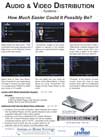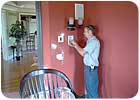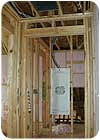
Advancing technology and declining prices are making security systems, home control, audio/video and other devices almost as standard in new homes as carpeting and appliances. Many dealers and installers have created builder programs to help them get in front of new home buyers before competitors can.
“To pre-wire or not to pre-wire” new homes under construction is one question. But there are many others, including “How can I work profitably with cost-conscious builders?” and “Can I sell home buyers more products beyond the basic package?” Here is how four companies have answered these questions and constructed successful and profitable builder programs.

American Home Systems (AHS), Alexandria, Va., customizes four-color catalog covers to individual builders’ graphics and uses advertising to build its message about audio/video systems.
PIONEERING A BUILDER PROGRAM
Network Alarm Services, Norman, Okla., has the oldest and largest builder program in central Oklahoma. “We are the pioneers,” maintains David Nelson, who oversees the 15-employee builder division for the dealer. “We have continued to evolve the program since its founding in 1994 to keep it attractive and valuable for builders and our company. Today, it’s the foundation of our business, generating about 80 percent of our RMR.”The program’s initial goal was to generate new recurring monthly revenue (RMR). “We worked with one builder and offered pre-wiring as an upgrade package on the 400-plus homes it built in a year,” describes Nelson. “The builder paid for the pre-wiring at cost and added it to the home’s price.
“We were given buyers’ names and the opportunity to present our security systems and monitoring services to them,” he relates. “The program quickly expanded. Within two years, we were wiring 1,500 to 1,800 houses a year, ranging in size from 900 to 11,000 square feet. That number has stayed fairly constant since then.”
In 1996, the company began to install security systems in homes at cost to the builders. “With the security system in place, selling monitoring services to the homeowner was relatively easy,” notes Nelson.
The challenge was convincing builders to put a system in every house instead of just the wiring. Three factors helped convince them.
“First, there was our prodding,” he stresses. “At the same time, there was growing demand from consumers for security systems and security system requirements and discounts from the insurance industry.”

The company’s program took another growth step in late 1997 by adding phone and cable distribution systems to security systems. Structured wiring packages are offered on a limited basis as upgrade options.
“Today, we do anything that is low voltage, including smoke alarms, CO detectors, CCTV, whole house audio and surround sound, access control, central vacuum systems and more,” describes Nelson. “Product sales have become as important to us as generating new RMR.”
Nelson says it takes time and effort to develop and sustain a successful builder program. “Cost is always a main concern for builders, particularly when interest rates are rising,” he concludes. “Delivering good service and products is key to keeping builders in the program.
“But, when it comes to costs and pricing, don’t rely on their estimates alone,” he advises. “Track costs yourself or you’re liable to have extra expenses when doing the final. One of the best things we’ve ever done is hire our own full-time inspector. Doing so has dropped customer service calls by 75 percent.”

Home buyers who visit the showroom of World Wide Security/GC Alarm Audio Video Design, Garden City, N.Y., purchase two to three times more in add-ons than buyers who do not come in.
BUILDING ON THE BACKBONE
MultiSource, Cincinnati, works with home builders in Cincinnati, northern Kentucky and eastern Indiana. President Michael Folzenlogen founded MultiSource in 1992 to be a one-stop shop for the full range of home technologies.On average, MultiSource wires 1,200 homes annually that range in price from $200,000 to $2 million. MultiSource’s recipe for builder program success and profitability is two-pronged.
First, the company seeks out builders interested in using home technology to deliver a higher quality product. Folzenlogen develops contacts by participating in home builder associations.
Secondly, MultiSource offers builders a basic structured wiring package for phone, voice and data, plus pre-wiring for distributed audio. Although all builders provide some type of phone and cable wiring in every home, distributed audio gives builders a competitive edge.
“This technology backbone gives buyers the flexibility to add on current technologies and adapt to new ones,” Folzenlogen notes.
Folzenlogen suggests designing packages for a range of home prices. “Builder programs aren’t just for high-end homes,” he advises. “Offering affordable packages for lower-price home buyers gives us the opportunity to develop more business.”
Tailor costs to the home price and the number of homes wired for each builder. The basic package is provided to builders at cost, which they pass through to buyers in the purchase price.
Folzenlogen considers the cost of the basic package as a marketing/advertising expense. “How much would we have to spend on advertising to generate 1,200 high quality prospects?” he quizzes.
As part of the program, builders are required to put every buyer in touch with MultiSource. “Buyers have an incentive to come to our showroom because they get pre-wiring in their new home and want to take advantage of our offer to design it to their needs,” explains Folzenlogen.
“When they see the products displayed in our showrooms, buyers often say they had no idea they had all these options, and they buy,” he declares. Add-on purchases range from $5,000 and $10,000 systems to $100,000 systems.
Folzenlogen also suggests keeping builders informed of their buyers’ additional purchases so they see the value of the relationship and the rebate amount to expect. MultiSource sends quarterly reports to each builder.
A recent report to a builder of $250,000 to $450,000 homes revealed that:
- 70 percent of buyers purchased additional phone, cable and voice products;
- 55 percent purchased additional audio products, such as speaker and volume controls;
- 40 percent purchased life security systems; and
- 15 percent purchased central vacuum systems.

MultiSource, Cincinnati, includes distributed audio, phone and cable in its basic structured wiring package to give builders a competitive edge.
LEARNING FROM EXPERIENCE
New home residential business has been the specialty of American Home Systems (AHS), Alexandria, Va., almost since its start in 1972. Increasing home buyer awareness of technology led the company to develop a builder program in 1999 to meet consumer demand and generate new business.“We made a few technology sales to builders and thought we knew what we were doing,” describes Paul Jablonski, general manager. “After inspecting the first houses, however, we realized we needed to expand our offerings and increase our installers’ expertise and quality control.”
While AHS was refining its program, a large national builder called. Impressed with an AHS presentation and uneasy about its own sales personnel’s ability to keep up with changing technology, the builder asked AHS to take over home electronics sales to buyers.
From that opportunity, business grew consistently. In 2005, AHS wired 1,700 new homes, primarily in Virginia, for approximately 30 builders offering homes from $300,000 and up.
“We worked with a builder of starter town homes one year, but upgrade purchases were too low to support our level of builder service,” notes Jablonski. “That’s why we focus on mid- to higher-priced homes.”
AHS has installed systems costing $100,000 and more for custom builders and ones priced from $40,000 to $50,000 for production builders.
Builders have a choice of two AHS programs: one in which home systems and electronics are offered only as an option, and the other in which home systems, such as structured wiring and security, are a standard feature.
AHS and builders work as partners. AHS creates 70-page custom catalogs of the options available for homes in each of the builder’s communities.
Four-color catalog covers are customized to the builder’s graphics, reinforcing that buyers are dealing with an established program from the builder rather than from an outside vendor.
When buyers contract for a new home, the builder sends them a catalog and notifies AHS of the sale. An AHS salesperson then arranges to meet with the buyer to discuss the buyer’s choices.
After that meeting, AHS provides buyers and builders with detailed plans. Builders receive a percentage of AHS’ option sales.
According to Jablonski, buyers of homes with one or more systems included as standard features are more likely to purchase upgrades and complementary options than buyers offered these systems only as an option.
A key reason is that buyers are more willing to meet with AHS because they have the opportunity to specify wiring locations for the TV, telephone and computer outlets included with their home and to add security devices that may be important to that buyer.
Buyers of homes with systems built in as standard features purchase on average approximately $3,000 per home in upgrades. Aside from additions to standard systems, the most popular upgrades are home theaters and whole house audio/video distribution.
“Quality control is the biggest challenge in a builder program,” asserts Jablonski. “We have about 30 to 35 employees and 15 installation crews out each day. We give our crews detailed installation instructions specific to each builder’s requirements.
“Then, to ensure all work is done to our standards, we have our inspectors check each house at various stages of construction and provide QC reports to the builder,” he explains. “The higher the number of installations, the greater the need for quality control and documentation.”

The structured wiring package offered as an upgrade by Network Alarm Services, Norman, Okla., reflects its ability to do anything low-voltage.
SELLING WITH A PERSONAL TOUCH
World Wide Security/GC Alarm Audio Video Design, Garden City, N.Y., focuses its builder program on million-dollar-plus custom homes, which are the dominant new construction projects in its market area. The company installs systems in 300 to 400 homes annually.The typical system ranges between $10,000 and $20,000. Builders include those the company has had relationships with for years and new builders the company recruited by offering free installation of basic alarm systems in return for access to their buyers.
“Technology has become an important part of American homes in the past few years,” says Joe Ingegno, owner, “and builders want to include it because it makes their houses stand out.”
Some builders in the program offer buyers a choice of low voltage packages that can be included in the purchase price. World Wide Security installs the one selected without interface with the buyer.
Other custom builders refer their buyers to World Wide Security, which the company much prefers. Buyers are invited to bring their blueprints to the company’s showroom.
Upon arrival, they are given a tour of the displayed home systems and a security technology expert explains how those can be configured to the buyer’s needs. The company then wires the home for systems selected by the buyer.
“When we deal directly with buyers, sales are two to three times higher and we have the opportunity to design the layout before installation,” says Ingegno. Most new home buyers choose what Ingegno calls the “standard audio video system,” which includes a plasma TV, surround sound system, at least six rooms of multi-room audio, and increasingly, structured cabling to every room.
As a rule of thumb, Ingegno estimates that integrated home systems in $2 million-plus homes tend to equal 7 percent to 10 percent of the home’s price. The company installs security systems but finds that buyers are far more price-sensitive on those than on the high-end components of home systems.
Home automation and control systems have not become “standard” choices for home buyers yet, but World Wide Security is installing an increasing number of these high-dollar systems. A key driver of those sales currently is energy conservation.
Ingegno believes relationships with home buyers are the key to the success and profitability of a builder program. His company forges those relationships by:
- Being a one-stop shop for all low-voltage products.
- Being a custom installer of those products. “If something custom needs to be done in the buyer’s home, we can handle it from beginningto end,” asserts Ingegno.
- Having a showroom. More than 90 percent of home buyers who come to his showroom purchase systems.
Referrals from the company’s satisfied home buyers make up a large portion of its new business outside of the builder program.


